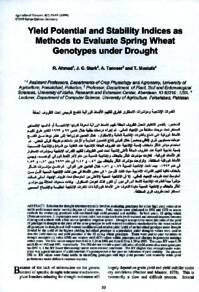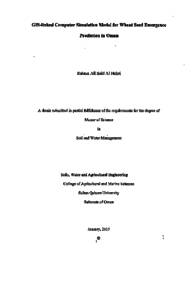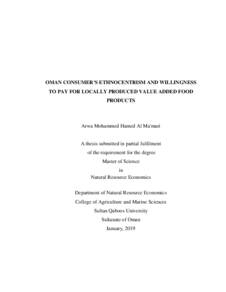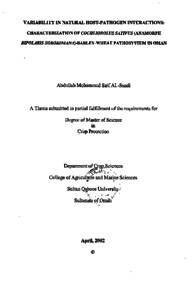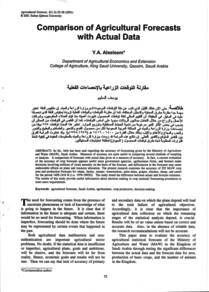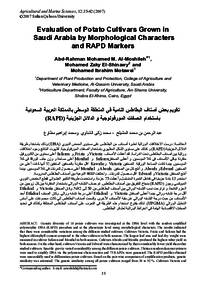Document
Grain yield and yield components of spring wheat genotypes at different moisture regimes.
Contributors
Publisher
Sultan Qaboos university
Gregorian
1998
Language
English
Subject
English abstract
Yield and developmental characteristics of crop genotypes grown at different levels of water availability are often used to select genotypes that are adapted to variable moisture environments. Field studies were conducted at Aberdeen, Idaho, USA in 1992 and 1993 to evaluate the effects of varying moisture supply on grain yield and yield components of spring wheat genotypes. In both years, 12 spring wheat (Triticum acstivum L.) genotypes were grown under three irrigation levels (well-watered, moderate water-stress and severe water-stress) imposed during the periods from mid-tillering to anthesis with a line source sprinkler irrigation system. Grain yield and yield components (spikes m-2, spikelets spike-1, kernels spikelet-1, kernels spike-1 and kernel weight) were used to evaluate the genotypic response to water stress. Overall, water stress caused a reduction in grain yield and yield components. Genotypes exhibited a large year-to-year variation in their ranks for grain yield. Medium-tall growing genotypes (IDO 367, IDO 369 and Rick) generally produced high yields under water stress conditions in 1992 (relatively dry year), while short -medium genotypes (WPB 926. Yecora Rejo and Pondera) produced high yields under water stress conditions in 1993 (relatively wet year). Chris and Serra were the lowest yielding genotypes under water stress conditions in both years Under moderate stress conditions, IDO 367 and Yecora Rojo had consistently high yields. Genotypie yield differences under water stress conditions were primarily related to the differences in the numbers of spikes m-2. Therefore, a tendency for spikes per unit area could be used to select wheat genotypes for improved drought tolerance high plasticity.
Member of
ISSN
2410-1079
Resource URL
Citation
Ahmad, R., Stark, J. C., Ahmad, N., & Tanveer, A. (1998). Grain yield and yield components of spring wheat genotypes at different moisture regimes. Journal of Agricultural and Marian Sciences, 3 (2), 13-19.
Arabic abstract
غالبا ما تستخدم الإنتاجية وخصائص التطور لأنواع المحاصيل عند مستويات الري المختلفة في الحبوب لانتخاب الأنماط الوراثية التي يمكن تأقلمها على بيئات الرطوبة المتغيرة. أجريت هذه الدراسة في أبردين - ايداهو بالولايات المتحدة الأمريكية في عامي 1992 و 1993م لتقييم تأثير كميات مياه الري المختلفة على إنتاجية الحبوب ومكوناته عند الأنماط الوراثية لقمح الربيع. في كلا العامين، زرعت اثنتي عشرة نمطا وراثيا لقمح الربيع (Triticum sativum L. ) في ثلاث مستويات ري مختلفة هي (ري كامل وإجهاد مائي معتدل وإجهاد مائي حاد) خلال الفترة من منتصف ظهور الخلفات وحتى مرحلة تفتح الأزهار، بواسطة نظام رش خطي، واستخدم إنتاجية الحبوب ومكوناتها (عدد السنبلات لكل متر مربع وعدد السنيبلات لكل سنبلة وعدد البذرات في كل سنيبلة و البذرات لكل سنبلة ووزن البذرة الواحدة) لتقييم مدى تحمل النمط الوراثي للإجهاد المائي. بشكل عام سبب الإجهاد المائي نقصا في إنتاج البذور ومكونات الإنتاجية كما أظهرت التركيبات الوراثية اختلافات كبيرة في الإنتاج من عام إلى آخر. وقد أعطت التركيبات متوسطة الطول إلى الطويلة ( IDO367 و 369 IDO وريك Rick) في عام 1992 (عام جاف نسبيا) محصولا عاليا تحت ظروف الإجهاد المائي بينما أنتجت الأنماط الوراثية القصيرة إلى المتوسطة WPB926) ويكوراروجو Yecorat Rajo وبونديرا (Pondera في عاد 1993 (عام رطب نسبيا) محصولا عاليا تحت ظروف الإجهاد المائي، كانت عينات كريس Chris وسييرا Serra الأقل إنتاجية بين التركيبات الوراثية المختلفة تحت الجهد المائي في كلا العامين. وكانت عينات 367 IDO ويكورا روجو هي الأكثر إنتاجية عندما كان الجهد المائي معتدلا. إن اختلاف إنتاجية التركيبات الوراثية تحت ظروف الإجهاد المائي بالاختلاف في عدد السنابل في المتر المربع بالدرجة الأولى وبالتالي يمكن استخدام الاتجاه لزيادة المرونة لدى عدد السنابل في وحدة المساحة، لانتخاب الأنماط الوراثية للقمح واللازمة لتحسين مدى تحمل القمح للجفاف.
Category
Journal articles


